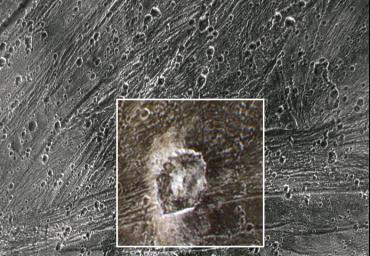
|
Kittu Dark Ray Crater
- Click the image above for a larger view
- Full-Res JPEG (692 x 480) (97.1 kB)
- Full-Res TIFF (692 x 480) (664.6 kB)
Caption:
View of the dark ray crater Kittu on Jupiter's moon, Ganymede. Kittu is seen in approximately true color, as imaged with the Galileo camera's violet, one micrometer, and near infrared filters. The crater shows a bright white central peak and rim, and dark brownish material surrounding it. Diffuse dark rays, sprinkled thinly atop surrounding grooved terrain, emanate from the impact site. The dark material dusted over the surface is probably part of a dark impactor (asteroid or comet) which was strewn across the surface upon impact. The impactor hit grooved terrain, and a straight segment of the crater's rim was created when a portion of the rim collapsed along the trend of an older fault.
North is to the bottom of the picture and the sun illuminates the surface from the left. The mosaic, centered at 0 degrees latitude and 335 degrees longitude, covers an area approximately 70 by 100 kilometers. The resolution in the color portion of this image is about 280 meters per picture element, while the resolution in the black and white portion is 145 meters per picture element. The images were taken beginning on April 5, 1997 from 6 hours, 39 minutes, 46 seconds Universal Time at a range of 14252 kilometers by the Solid State Imaging (SSI) system on NASA's Galileo spacecraft.
Background Info:
The Jet Propulsion Laboratory, Pasadena, CA manages the Galileo mission for NASA's Office of Space Science, Washington, DC.
This image and other images and data received from Galileo are posted on the World Wide Web, on the Galileo mission home page at URL http://www.jpl.nasa.gov/galileo/sepo .
Cataloging Keywords:
| Name | Value | Additional Values |
|---|---|---|
| Target | Ganymede | |
| System | Jupiter | |
| Target Type | Satellite | |
| Mission | Galileo | |
| Instrument Host | Galileo Orbiter | |
| Host Type | Orbiter | |
| Instrument | Solid-State Imaging (SSI) | |
| Detector | ||
| Extra Keywords | Asteroid, Color, Comet, Crater, Dust, Impact, Infrared | |
| Acquisition Date | ||
| Release Date | 1998-07-15 | |
| Date in Caption | 1997-04-05 | |
| Image Credit | NASA/JPL/Brown University | |
| Source | photojournal.jpl.nasa.gov/catalog/PIA01611 | |
| Identifier | PIA01611 | |
